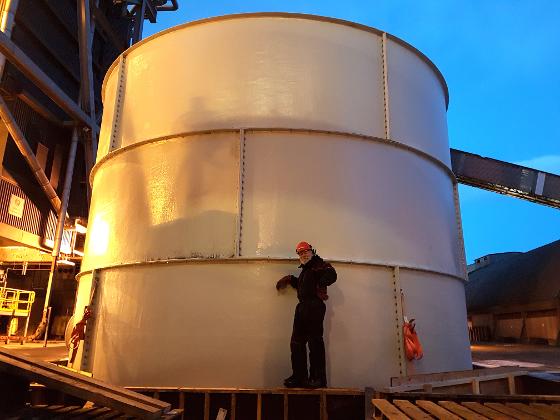Mass cultivation of diatoms at Finnfjord AS
The industrial part of the project started January 2015, i.e. experimental mass cultivation of northern/Arctic diatoms integrated in the production line at the ferrosilicon producer Finnfjord AS. The project is a cooperation between The Arctic University of Norway and Finnfjord as, and is at present financed by Norwegian Regional/Government Funds in addition to the cooperation partners.
Cultivation of photoautotrophic microalgae at high concentrations demands CO2 at levels far above normal sea concentrations. We therefore utilize the CO2 in the factory smoke as a carbon source in the photosynthetic production process. Likevise NOx in the factory fume taken up by the diatoms functions as an inorganic N source. The main product at the factory is ferrosilicon that is an alloy of iron and silicon. Diatoms have silica scales, and we therefore also utilize silicate from the factory in the algae production process.
The project concept is unique and based on a light utilization efficient photobioreactor concept, combined with carefully selected growth efficient large diatoms, adapted to low temperatures and irradiance levels. Further, the cultivated species have high abilities to handle low pH levels. This is necessary since addition of factory fumes with high (7-8%) CO2 contents lowers the pH in the photobioreactors. Among the results achieved during the test cultivation period is that the selected diatom species in combination with high pCO2 values increases both total lipid production and omega-3 levels. In addition, by applying the appropriate cultivation procedures we can cultivate >6 months without contamination or fouling of the photobioractors.
The produced biomass have high nutritional value, i.e. 10-20% lipid (50 % omega-3), 30-40% protein (all essential amino acids) and carbohydrates. The main product is whole (bulk) fish feed, but other applications are also considered (biofuel, bioethanol, health food, pigments, enzymes) in addition to that the algae are bioprospected. One exciting “product” is silica battery anodes (cooperation NTNU Trondheim) to boost battery capacity markedly.
At present we have the world’s largest vertical column photobiorecator (300 000L) running, and the biomass is at present being tested as eco-feed for aquacultured salmon.
The project is part of the ARC (Arctic Centre for Sustainable Energy) and CCU (Carbon Capture and Utilization) initiatives at The Arctic University of Tromsø UiT, hence also aspects of sea environment, social science, economy, alternative CO2 utilization and technology are included.
